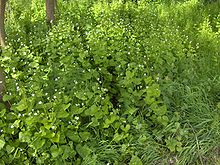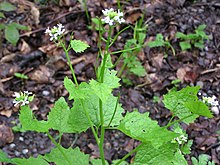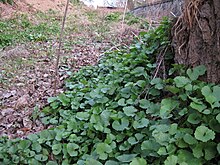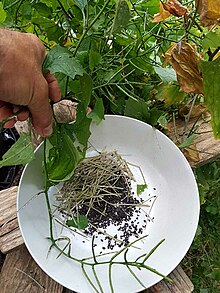Garlic mustard
| Garlic mustard | ||||||||||||
|---|---|---|---|---|---|---|---|---|---|---|---|---|

Garlic mustard ( Alliaria petiolata ) |
||||||||||||
| Systematics | ||||||||||||
|
||||||||||||
| Scientific name | ||||||||||||
| Alliaria petiolata | ||||||||||||
| ( M.Bieb. ) Cavara & Grande |
The garlic mustard ( Alliaria petiolata (M. Bieb) Cavara & Grande. , Syn .: Alliaria officinalis .. Andrz ex M. Bieb ), also garlic herb , leek herb , Knoblauchhederich called, is a plant that the family of the cabbage family belongs (Brassicaceae) . It is widespread in Europe . The common names refer to the garlic scent that arises when the leaves are rubbed.
description
Appearance and leaf
The garlic mustard is a biennial to perennial herbaceous plant that reaches heights of 20 to 100 centimeters. It has a long tap root . The stem is slightly square, in the basal area it develops weak hairs. The long-stalked, kidney-shaped basal leaves are notched at the edge. The stem leaves are arranged alternately. They have a heart-shaped leaf blade with a curved edge.
Inflorescence and flower
The garlic mustard blooms from April to July. There are many flowers in a terminal, racemose inflorescence .
As is typical for cruciferous vegetables, the hermaphrodite flowers are four-fold and 5 to 8 millimeters in size. The four petals and four white sepals are free. The flowers have six stamens , of which the two on the sides are significantly shorter. The nectar glands are arranged in a ring on the flower base, at the base of the stamens. The ovary is green and slender and divided into two compartments by a partition.
Fruit and seeds
The fertilized ovary develops into a pod three to seven centimeters long. The pod is thin, green when unripe and, with a diameter of just two millimeters, not significantly thicker than the former flower stalk. It contains six to eight seeds in each of the two compartments, each only about three millimeters long and ripe and blackish-brown in color.
With increasing ripeness, the color of the pod changes from green to light brown due to the drying process that then takes place. When the pod is fully ripe, the two fruit flaps gradually tear open from bottom to top and finally fall off. The seeds are not yet scattered. They are attached to the septum of the pod with short stalks.
Chromosome number
The species has chromosome number 2n = 36 or 42.
ecology
The garlic mustard is a biennial (to perennial) hemicryptophyte and a stem plant. It is up to 1 m high, but fruiting plants only 5 cm high have been found in poor locations, which is a good example of the range of modifications of this species.
For optimal use of light, the lower leaves are relatively large and long-stemmed and become significantly smaller and shorter-stemmed towards the top. The plant has an allelopathic effect on the growth of mycorrhizal fungi through chemical substances and inhibits or prevents this. Since, in turn, many seedlings of trees depend on these fungi, the garlic mustard thus indirectly prevents the growth of wood in its immediate vicinity.
Synecology
The garlic mustard offers the nectar that collects at the base of the flower freely accessible. In addition to bees , flies and hover flies , beetles are also found as pollinating insects. In addition to cross-pollination, garlic mustard can be self-pollinated .
The garlic mustard spreads its seeds mainly through semachory . If the stalks on which the pods hang at an angle are set in motion by the wind or by animals or people passing by, the mature seeds become detached from the pod and are scattered. Like many other plants, the garlic mustard has several spreading strategies . When it rains, the seeds slimy and stick to the fur of animals passing by. With this strategy, the so-called epichory , they are dragged over a greater distance than with the semachory. The vegetative reproduction is ensured by underground runners and root shoots.
The butterfly forest board game ( Pararge aegeria ) likes to suckle on the nectar of the garlic mustard. It also serves the Orange Tip ( Anthocharis cardamines ) as a nectar plant, and at the same time next to the lady's whose caterpillars feed plant. It is also used as a fodder plant by the highly endangered flour-colored rock spider ( Lithostege farinata ). Polyphagous the caterpillars of the agate owl ( Phlogophora meticulosa ) and the green vein whitefly ( Pieris napi ) feed on the garlic mustard. The caterpillars of the cruciferous leaf tensioner ( Xanthorhoe designata ) and common leaf tensioner ( Xanthorhoe fluctuata ) are oligophagous .
Occurrence
The garlic mustard grows wild in most parts of Europe , the Middle East and Central Asia as far as China and India and is also found in places in North Africa .
It is actually a plant species of deciduous forests , but thrives particularly well in bushes and hedges as well as on walls and paths , in gardens and on rubble sites (ruderal sites). There she is often in the company of nettles . Like them, she appreciates fresh, nitrogen-rich clay soils. Today it is often found in shady parks and in wooded areas in urban areas. The garlic mustard is a nitrogen pointer and a penumbra plant. It can also grow epiphytically in the forks of trees. It is a species of character of the order Glechometalia hederaceae. In the Allgäu Alps in Bavaria near the Scheuen-Alpe southeast of Balderschwang , it rises up to 1080 meters above sea level.
The garlic mustard is a neophyte in North America and South America that is considered an invasive plant . It was probably deliberately brought to North America as a culinary herb and medicinal plant by European settlers (so-called ethelochory ).
use
The garlic mustard played a certain role as a spice plant in the Middle Ages and early modern times and was increasingly being forgotten as spices became cheaper and therefore affordable for all sections of the population. Similar to wild garlic , the modern herbal kitchen is gradually rediscovering the garlic mustard. However, garlic mustard cannot be used in as diverse a variety of ways as wild garlic, as its flavors are more volatile.
The garlic mustard as a medicinal plant
The garlic mustard was previously used for medicinal purposes. It has an antiseptic , slightly diuretic and expectorant effect. It is also said to have anti-asthmatic properties. In folk medicine , poultices were made from the leaves for the treatment of insect bites and worm diseases.
Use as a spice

Garlic mustard ( Alliaria petiolata ) was known as early as 4000 BC. Used as a spice in the Mesolithic BC , as shown by phytolites on shards of clay pots from Neustadt in Holstein on the Baltic Sea and Stenø in Denmark. This makes the garlic mustard the oldest known local spice.
In the Middle Ages, garlic mustard with its peppery-garlic-like taste was mainly used by the poorer population who could not afford the expensive spices. For this reason, it was even grown in gardens in the Middle Ages. The leaves are collected for eating from April to June. The Englishman John Evelyn , who wrote a cookbook Acetaria, a Discourse on Sallets in 1699 , named the plant among other things Jack-by-the hedge - which is to be understood as an indication of its frequency - as well as Alliaria and sauce alone . He also pointed out that the plant has many valuable medicinal properties and is "especially eaten as a salad by people in the country, where it grows wild under banks and hedges". Even today, the young leaves of the garlic mustard are still often used for sandwich fillings in England.
The pungent taste of garlic mustard is due to essential oils and the glucoside sinigrin , which is similar to the glucosides found in other members of the cabbage family . However, the peppery-garlic-like taste evaporates when cooked. Garlic mustard must therefore be added raw to dishes. The modern herbal kitchen has rediscovered the garlic mustard and mixes the finely chopped leaves in salad dressings and quark or cream cheese mixes . In addition, the flavorful flowers are used to decorate salty sorbets and salads. The black seeds of the garlic mustard can be used in a similar way to peppercorns and have a very pungent taste.
swell
literature
- Hansjörg Küster : A brief cultural history of spices. Verlag C. H. Beck, Munich 1997, ISBN 3-406-42025-7
- Elisabeth Lestrieux, Jelena de Belder: The taste of flowers and blossoms. Dumont Verlag, Cologne 2000, ISBN 3-7701-8621-4
- Angelika Lüttig & Juliane Kasten: Rose hip & Co: Flowers, fruits and spread of European plants. Fauna Verlag, Nottuln 2003, ISBN 3-935980-90-6
- Ruprecht Düll , Herfried Kutzelnigg : Pocket dictionary of plants in Germany and neighboring countries. The most common Central European species in portrait. 7th, corrected and enlarged edition. Quelle & Meyer, Wiebelsheim 2011, ISBN 978-3-494-01424-1 .
Individual evidence
- ^ Dietrich, Heinrich: Frühblüher from Jena , EchinoMedia Verlag, 1st edition 2008, ISBN 978-3-937107-15-8 , page 95ff
- ↑ a b Erich Oberdorfer : Plant-sociological excursion flora for Germany and neighboring areas . 8th edition. Page 473. Stuttgart, Verlag Eugen Ulmer, 2001. ISBN 3-8001-3131-5
- ↑ The garlic mustard as a butterfly plant at Flora Web
- ^ Alliaria in the Germplasm Resources Information Network (GRIN), USDA , ARS , National Genetic Resources Program. National Germplasm Resources Laboratory, Beltsville, Maryland.
- ↑ Erhard Dörr, Wolfgang Lippert : Flora of the Allgäu and its surroundings. Volume 1, IHW, Eching 2001, ISBN 3-930167-50-6 , p. 573.
- ^ A b Jonathan Clayden, Nick Greeves, Stuart Warren, Peter Wothers: Organic Chemistry , Oxford University Press, 2001, pp. 1367-1368. ISBN 978-0-19-850346-0 .
- ^ Suzi Gage: Prehistoric Europeans spiced their cooking. BBC News, August 21, 2013, accessed August 22, 2013 .
- ↑ Saul Hayley, Madella Marco, Fischer Anders, Glykou Aikaterini, Hartz, Sönke, Oliver E. Craig: Phytoliths in Pottery Reveal the use of Spice in European Prehistoric Cuisine. PLoS ONE 8 (8): e70583. doi : 10.1371 / journal.pone.0070583 , August 21, 2013, accessed on August 22, 2013 (English).
Web links
- Garlic mustard. In: FloraWeb.de.
- Distribution map for Germany. In: Floraweb .
- Alliaria petiolata (M. Bieb.) Cavara & Grande In: Info Flora , the national data and information center for Swiss flora . Retrieved October 29, 2015.
- Distribution in the northern hemisphere according to: Eric Hultén , Magnus Fries: Atlas of North European vascular plants 1986, ISBN 3-87429-263-0
- Thomas Meyer: Data sheet with identification key and photos at Flora-de: Flora von Deutschland (old name of the website: Flowers in Swabia )
- Literature on Alliaria petiolata in the Kew Bibliographic Databases (English)
- Photos of Alliaria petiolata on the website of Walter Obermayer's Institute for Plant Sciences
- Use in folk medicine





